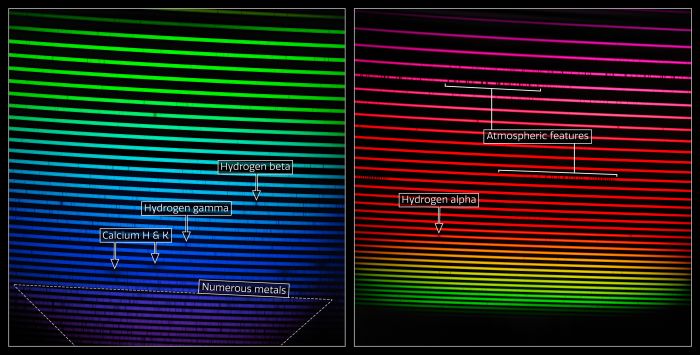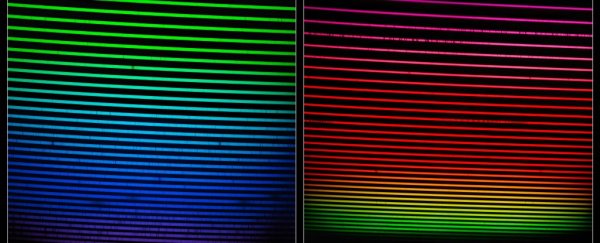It looks a bit like neon artwork from the '80s. But what the image above really shows is much, much cooler.
It's a star, and the first light image captured by the newest instrument on the Gemini South telescope, the Gemini High-resolution Optical SpecTrograph, or GHOST. What it shows is the entire optical spectrum of light emitted by a star named HD 222925, in amazing resolution.
"This is an exciting milestone for astronomers around the globe who rely on Gemini South to study the Universe from this exceptional vantage point in Chile," said Jennifer Lotz, director of Gemini Observatory.
"Once this next-generation instrument is commissioned, GHOST will be an essential component of the astronomer's toolbox."
The light we can actually see being emitted by stars is chock full of hidden details describing the distant sun's features. It can show us whether a star is moving by how light shifts from one end of the spectrum to the other, while variations in brightness can reveal internal oscillations, which can be analyzed by asteroseismologists.
The entire spectrum of the star also reveals what it's made of, which in turn can be used to learn all sorts of things about it, such as how old the star is, and where it formed.
That's because different elements absorb and re-emit light differently. When astronomers look at a star's spectrum, they can look for brighter and dimmer wavelengths, and use that information to determine which elements are present in the star's atmosphere.
You can see what the dimmer features, known as absorption lines, look like in the image below.
 The labeled spectrum of HD 222925. (International Gemini Observatory/NOIRLab/NSF/AURA/GHOST Consortium)
The labeled spectrum of HD 222925. (International Gemini Observatory/NOIRLab/NSF/AURA/GHOST Consortium)
This technique was recently used on Hubble observations HD 222925, a really oddball star located around 1,460 light-years away. Spectral analysis revealed the most elements ever seen in a star's atmosphere, a whopping 65 – most of which were heavy elements that can only form in extremely energetic events, such as a neutron star collision or supernova.
That means that HD 222925, which is in a very late stage at the end of its life, probably formed from a cloud that was rich in these elements in the first place, seeded by the deaths of stars that had come before it.
The new images from GHOST have not revealed anything new about the star – yet. The star was the target of the instrument's 'first light', the first image taken by a new telescope to check the telescope is working, and how well. This allows scientists to make any necessary first adjustments to the instrument.
The commissioning phase comes next, in which scientists and technicians will put GHOST through its paces to make sure the instrument is performing as intended.
Once that stage is complete, and any further adjustments made, GHOST will be ready for scientific observation, probably around the first half of next year.
That will be something to look forward to. GHOST, which took 10 years to construct, is 10 times more powerful than Gemini's other major optical spectrograph, GMOS. It is, scientists say, the most powerful and sensitive spectrograph of its kind currently in operation on comparable telescopes.
It's expected that GHOST will be able to provide fascinating insights on stars identified as interesting targets by other telescopes and surveys, and deliver us many more stars, split into their constituent wavelengths – beautiful 'star-bows' that will hopefully unlock many hidden secrets of the Milky Way.
The images were published by NOIRLab's International Gemini Observatory here.
